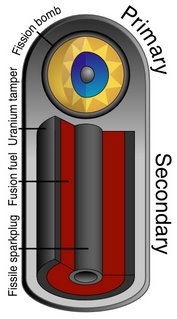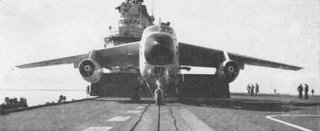Flightdeck Friday - Nuclear Whales
Inspired Genius
It is 1947 and Ed Heinemann of the Douglas Aircraft Corporation is perplexed. Charged with leading the team that is designing Douglas’ entry in the Navy’s heavy attack aircraft competition, he is trying to figure out how to accomplish this feat in an airframe that would weigh in at less than 68,000 lbs, the maximum that the Midway-class carriers’ flight decks could sustain. His competitors over at Curtis and North American were gearing up for something closer to 100,000 lbs, a plane that would easily be accommodated on the Navy’s first supercarrier, the
Part of the reason for the extreme secrecy was the number of nuclear weapons in the
Heinemann was convinced of a couple of things, chief of which was that the
Nuke Whales
 XJ40 engines were replaced by more powerful Pratt & Whitney J57s (9,700lb s.t. vs 7,000lb s.t.). The A3D Skywarrior was Big – 76 ft long with a wingspan of 72 ft and weighing, fully loaded 82,000 lb for the definitive AD3-2 (A-3B variant). With wings spread, one Whale occupied the area of four AD-2’s with their wings folded, a significant chunk of real estate on an already tight carrier deck. More importantly, it had a payload of 12,000 lb – allowing carriage ranging from 12 x 500 lb Mk 82 conventional bombs up to 1 x 7.600lb Mk15 nuclear weapon.
XJ40 engines were replaced by more powerful Pratt & Whitney J57s (9,700lb s.t. vs 7,000lb s.t.). The A3D Skywarrior was Big – 76 ft long with a wingspan of 72 ft and weighing, fully loaded 82,000 lb for the definitive AD3-2 (A-3B variant). With wings spread, one Whale occupied the area of four AD-2’s with their wings folded, a significant chunk of real estate on an already tight carrier deck. More importantly, it had a payload of 12,000 lb – allowing carriage ranging from 12 x 500 lb Mk 82 conventional bombs up to 1 x 7.600lb Mk15 nuclear weapon.
The Mk15, first produced in 1955 and deployed beginning in 1956, was a staged weapon
 (Teller-Ulam design), using radiation implosion from a fission nuclear primary to implode a secondary stage and a yield of 3.8Mt. Unlike more modern thermonuclear bombs, the Mark 15 used a secondary which was primarily HEU (highly enriched uranium), which generated most of its energy from nuclear fission reactions once the primary imploded it. There was a thermonuclear core which underwent fusion reactions, but most of the energy came from the HEU fissioning. The HEU fission was enhanced by fusion stage neutrons, but would have generated a very significant fission yield by itself. Incidentally, the diameter of the Mk15 was 35 inches.
(Teller-Ulam design), using radiation implosion from a fission nuclear primary to implode a secondary stage and a yield of 3.8Mt. Unlike more modern thermonuclear bombs, the Mark 15 used a secondary which was primarily HEU (highly enriched uranium), which generated most of its energy from nuclear fission reactions once the primary imploded it. There was a thermonuclear core which underwent fusion reactions, but most of the energy came from the HEU fissioning. The HEU fission was enhanced by fusion stage neutrons, but would have generated a very significant fission yield by itself. Incidentally, the diameter of the Mk15 was 35 inches.
Carrier Operations
From the start, the operating order for the A3 would be different from the AJ Savage – it would deploy as an integrated part of the carrier’s airwing. No offloading to Port  crews in spotting and placement on the catapult and proved to be a demanding aircraft in the groove (neutral to unstable in pitch and airspeed that was difficult to control in the landing configuration), the first full deployment by the A3D was still a major success. Proving in particular its night/all-weather nuclear delivery capabilities to Navy and NATO leaders, the pairing of the A3D and the Forrestal-class carrier looked to ensure the longevity of the carrier, a not inconsiderable feat in the face of a determined assault from the Air Force, especially from SAC.
crews in spotting and placement on the catapult and proved to be a demanding aircraft in the groove (neutral to unstable in pitch and airspeed that was difficult to control in the landing configuration), the first full deployment by the A3D was still a major success. Proving in particular its night/all-weather nuclear delivery capabilities to Navy and NATO leaders, the pairing of the A3D and the Forrestal-class carrier looked to ensure the longevity of the carrier, a not inconsiderable feat in the face of a determined assault from the Air Force, especially from SAC.
Unfortunately, subsequent deployments were increasingly less successful leading to much concern and criticism in the corridors of naval aviation leadership, particularly from 6th Fleet. Eventually, it reached a pitch where serious review and correction was required. Tapped for this job was CAPT J.D. Ramage. As head of the heavy attack wing, Ramage set about correcting deficiencies in pilot and bombardier/navigator training and experience and community morale.
The Whale continued to evolve in capabilities and employment. It would be deployed on the smaller Essex-class carriers as well as continuing to deploy on Forrestal and later,
smaller Essex-class carriers as well as continuing to deploy on Forrestal and later,
Specifications (A3D-2/A-3B Skywarrior)
General characteristics
- Crew: 3
- Length: 76 ft 4 in (23.27 m)
- Wingspan: 72 ft 6 in (22.1 m)
- Height: 22 ft 9.5 in (6.95 m)
- Wing area: 812 ft² (75.4 m²)
- Empty weight: 39,400 lb (17,900 kg)
- Loaded weight: 70,000 lb (31,750 kg)
- Max takeoff weight: 82,000 lb (37,200 kg)
- Powerplant: 2× Pratt & Whitney J57-P-10 turbojets, 10,500 lbf (46.7 kN) each
Performance
- Maximum speed: 530 knots (610 mph, 980 km/h)
- Cruise speed: 450 knots (520 mph, 840 km/h)
- Range: 1,325 mi (2,130 km)
- Service ceiling: 41,000 ft (12,500 m)
- Rate of climb: ft/min (m/s)
- Wing loading: 86.2 lb/ft² (421 kg/m²)
- Thrust/weight: 0.30
Armament
- Guns: 2× 20 mm (0.787 in) cannon in tail turret
- Bombs: 12,000 lb (5,400 kg) of free-fall bombs, including any combination of
- 12× 500 lb (230 kg) Mark 82 bombs or
- 6× 1,000 lb (450 kg) Mark 83 bombs or
- 1,600 lb armor-piercing bombs or
- 500 lb Mark 50 bombs or
- 1,000 lb Mark 36 bombs or
- 2,000 lb Mark 25 mines or
- 1× Mark 15 free-fall nuclear weapon












|